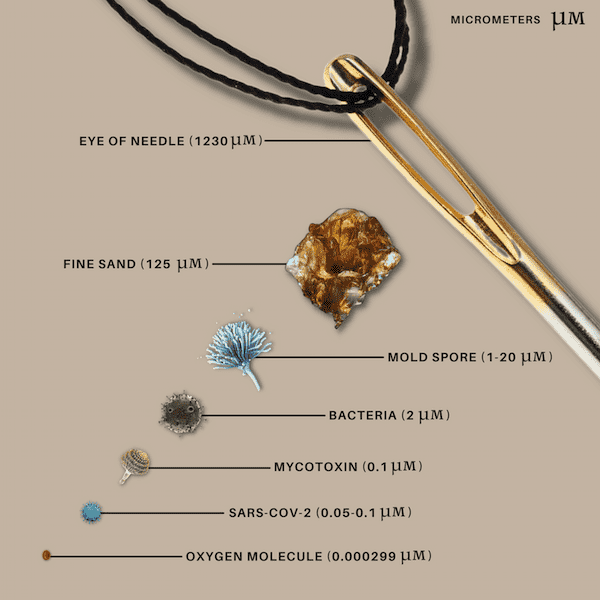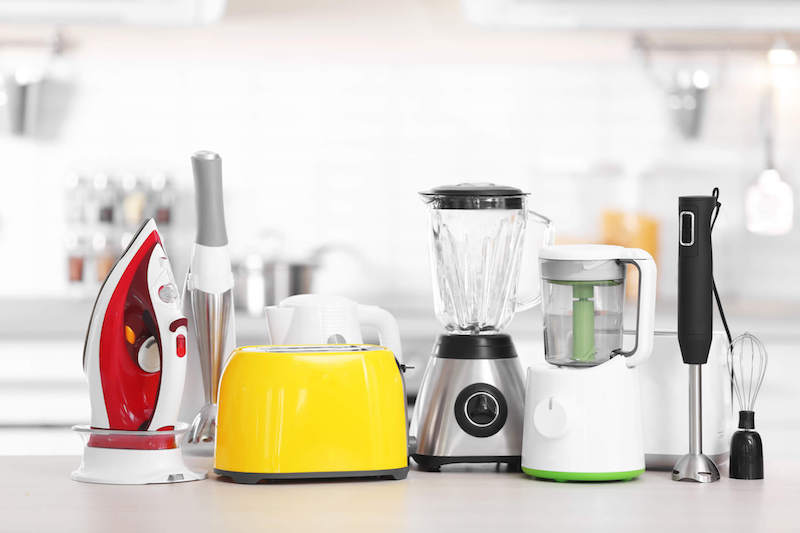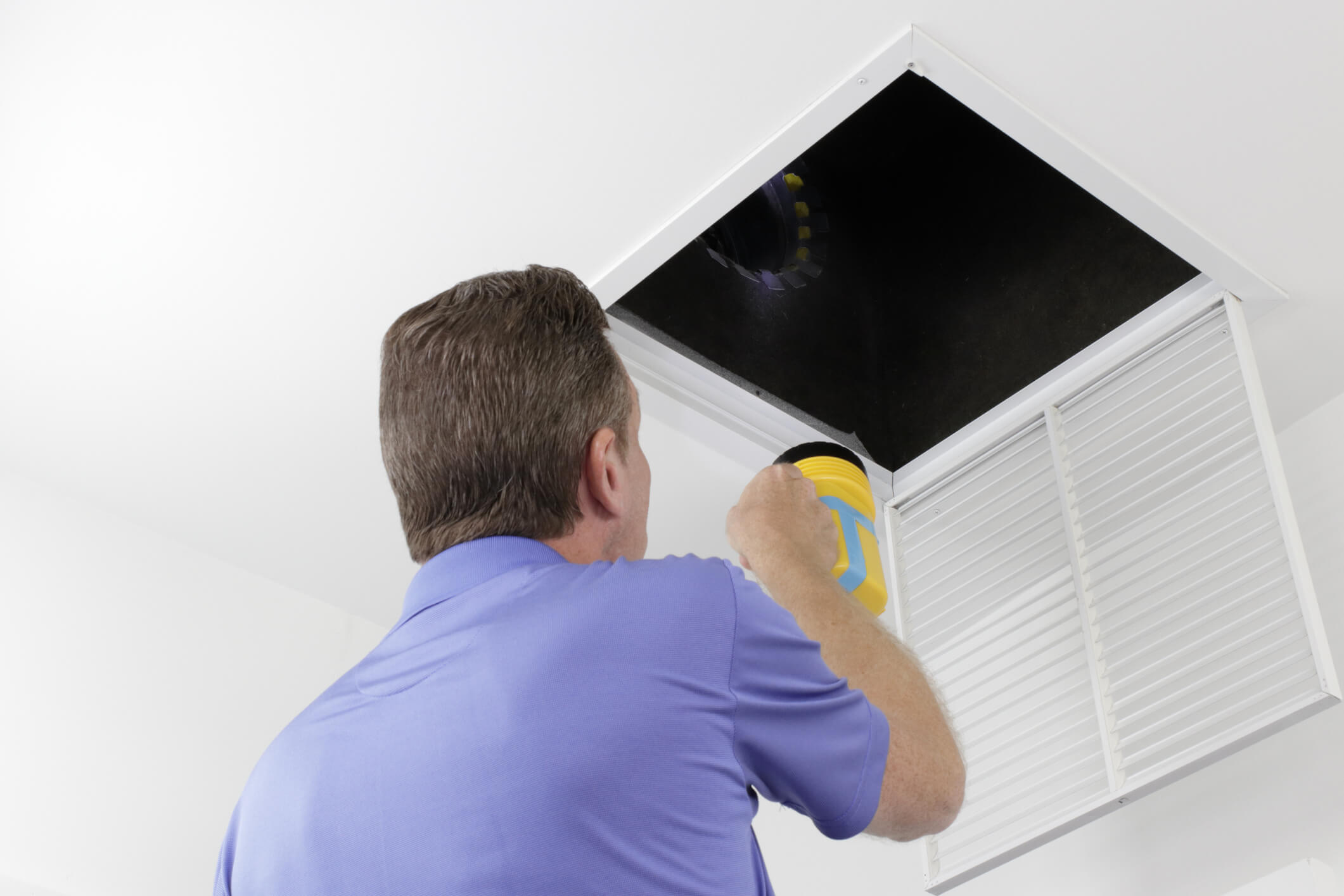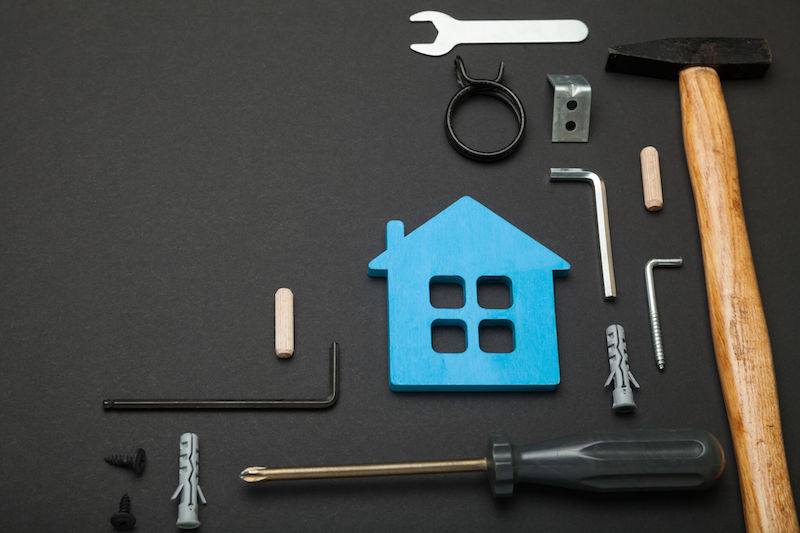Home maintenance is rarely a fun and glamorous job. Not to mention, it takes up some of the few precious free hours we have throughout the day. Sadly for us, these steps necessary to help make sure our homes don't crumble to the ground and fall to ruin. (insert sad sigh). Or, from developing a huge mold colony that tanks the indoor air quality and causes your immune system to go haywire. Bet that thought never crossed your mind when thinking about home maintenance! Avoiding this fungus extravaganza is why taking a look at the top places to check for mold will quickly become your favorite routine home maintenance chore.

Also, creeping around your home every so often looking for mold is super easy! Just don’t do it at night because then it’s kinda scary... Some of these inspection locations are a little dark.
Back to home maintenance, though. Society rarely discusses this fungus among us and the pitfalls of having it grow in our homes. And prevention tactics? Forget about it. That’s why it’s important to stay up to date on all things moldy, increase your personal mold awareness, and actively work to keep this indoor contaminant out of your home.
Otherwise, you could be living in an air bubble filled with moldy particles, which is a serious no-no for indoor air quality and your health. Here’s why peeking at the top places to check for mold will be your new obsession.
What is Mold and Why Should You be Obsessed with the Top Places to Check for Mold?
Mold is a type of fungus with over 100,000 species identified so far.¹’² These species come in a kaleidoscope of colors, textures, and shapes, and they’re found throughout the entire planet. Every species of mold also reproduces by creating microscopic spores and releasing them into the air. These spores will ride that air current wherever that leads and stick to any surface they come into contact with.
The key thing to remember is that these spores are microscopic and they’re also everywhere. Even inside of your home! That isn’t a problem unless the spore stumbles on a nice little surface with all of the components it needs to survive and thrive, and if that surface happens to be in your home. Mold in nature? A huge part of ensuring processes like decomposition run smoothly. Mold growth in the home? A serious indoor contaminant and an enemy to your body.
Unfortunately, ideal growing conditions can pop up in a home in the blink of an eye.
A spore only needs four key components to transition in the world of the living:³
- Oxygen (this barely counts because they need very little, hence why mold can grow in walls)
- Temperature (40-90 degrees Fahrenheit is ideal, but some species can survive at extremes)
- Food (they’re like teenagers, they eat everything)
- Moisture (the often missing ingredient)
With the first three components fairly easy to come by, moisture is typically the aspect of growth that’s missing. Throw in a damp carpet, a leaky windowsill, a malfunctioning refrigerator, or a humid bathroom that's been wet for 24-48 hours, and bam, there’s now a moldy dream home in your home. Or, a hidden leak! Hence, why looking at the top places to check for mold is so important in the battle against this fungus.
Mold Growth: a Healthy Indoor Environment No-No
A mold spore is similar to a seed. It’s not actively growing, so it will just continue to live its own solitary life, floating around and hoping for a nice place to settle down and grow. These are fairly easy to remove from the home, which is why deep cleaning is another mold prevention and home maintenance task in addition to inspecting the top places to check for mold.
But, back to the spore. Once it finds a habitable environment, it will put down roots called hyphae and start to release more and more spores into the air. First of all, the roots make mold difficult to remove. Secondly, a moldy factory pumping spores into the home is terrible for indoor air quality. Some species of mold can also release microscopic toxins called mycotoxins, which is just another pain for your immune system.⁴ Also, it’s yet another particle being added to your indoor air.

With how homes are built nowadays, tighter and with little airflow between the inside and outside environment, all of those spores and potentially toxins remain trapped within the walls of your home. If it’s a hidden moldy situation, this could go on for quite some time before you realize there’s a serious indoor contaminant lurking around in your home.
A moldy problem left unattended leads to more and more particles throughout the home, including on all of your belongings. Also, the higher the number of spores, the higher the chances that one of them will stumble on another fungal dream home and create a second, third, or fourth mold factory.
Aka, a moldy nightmare, and why peeking at the top places to check for mold is crucial. Yes, you’ll hear that statement a few more times just to make sure it digs deep into your brain!
Why is Mold Growth Dangerous and Looking at The Top Places to Check for Mold My New BFF?
In short, it’s the arch-nemesis of your immune system. Okay, maybe not arch-nemesis, but they’re definitely not friends.
Mold spores and toxins are small. Like, so small that you can breathe them in, which is why they’re called particulate matter.

As the EPA states, particulate matter is inhalable and falls into two categories:⁵
- PM10: particles that have a diameter of around 10 micrometers or less.
- PM2.5: fine particles that have a diameter of around 2.5 micrometers or less.
With mold spores being around 1-20 microns and mycotoxins being around 0.1 microns on average, they happen to fall into that breathing-in range. Also, to put it into perspective, a micron is one-millionth of a meter. You’d have to line up 1,000 microns in a row to equal the distance between those tiny millimeter lines on a ruler. The particles you’re dealing with are small!
That’s where the health portion comes into play.
When you encounter a few spores and toxins throughout the day, which is impossible to avoid, your immune system will descend in a jiffy and kick them out of your body. Typically, this isn't a problem at all because your immune system rocks.
However! When your immune system is facing down an army of moldy particles and toxins that you’re breathing in every single time you inhale, that's a problem. Especially since humans take 20,000 breaths per day on average.⁶ Talk about a seriously epic battle.
Your immune system will try to keep up with this onslaught, but it can eventually get overwhelmed, run-down, and/or malfunction. This can lead to a slew of adverse health reactions and open the door for other diseases like Candida and Lyme to sneak in and start causing mayhem.

Some of the symptoms associated with mold toxicity include:
- Runny nose
- Watery eyes
- Respiratory issues
- Rashes
- Hair loss
- Neurological issues
- Hormone imbalances
- Chronic fatigue
- Brain fog
- Digestive problems
Researchers are still hard at work trying to figure out exactly how and why exposure affects the body, but it’s a tricky subject to nail down. Factors such as genetics, immune system status, species of mold, length of exposure, volume of particles, and presence of mycotoxins all play a role. While someone in the home may only experience the occasional runny nose, another may develop over 30 symptoms as their body attempts to fight off all of those foreign particles. ⁷’⁸’⁹’¹⁰
The risk of developing an illness is motivation enough to actively work to prevent this fungus among us from living and growing in our home. No one wants to live in a moldy air bubble. What easier way to start accomplishing this than by creeping on the top places to check for mold?!
The Top Places to Check for Mold in Your Home
As mentioned earlier, hidden mold growth can lead to an indoor environmental nightmare. All of those particles are just floating around, naked to the human eye, causing your immune system to stress the heck out. With so many nooks and crannies in a home, mold can sneak in faster than the slasher from Scream.
There’s no better way to prevent this from happening than by checking out the top places to check for mold.
All it takes is a little bit of time, minimal effort, and an adventure around the house. So grab a flashlight and let's get going. Make sure to use your nose as well while you’re hunting. Mold growth causes a damp, musky, earthy smell. If you encounter that, there could be hidden fungus around.
The key places you’re going to want to pay attention to are the areas you don’t often frequent, but can easily develop a hidden water problem. Remember, moisture is mold’s best friend, so the idea is to check and make sure a hidden water event like a leak didn’t happen. The faster you catch an issue, the less chance that mold will move in.

Also, catching a mold problem early can significantly reduces the amount of remediation and decontamination required to get your home back in tip-top shape. Less remediation means less money!
The top places to check for mold are:
- The Attic: Creepy? Yes. Necessary? Also yes. Use the flashlight to scour the roof for any leaks, any piping or vents, the furnace or water heater, and the insulation.
- The Basement: Check the floor, ceiling, walls, vents, windows, pipes, and any other cracks or crevices you can find.
- Crawlspaces: This one will be the least fun, but it’s a huge moldy hotspot! So, hype yourself up and shine that flashlight all over the insulation, flooring, beams, and anything else you see down there.
- Underneath Sinks: This one is easy, which is good because mold loves the underneath of your sink. Examine the piping, every crack and crevice in the cabinet, and the area directly underneath the sink.
- Appliances: Any appliance that deals with water can become a moldy dream home! So, check the dishwasher, refrigerator, blender, microwave, oven, coffee maker, washing machine, and HVAC system. Pay close attention to all of the nooks and crannies as well; that’s where moisture can build up and allow mold to sneak in.
- Toilet Tanks: Also easy! Lift the toilet tank lid and take a good look inside the tank and under the lid.
- Caulking and Grout: Check any caulking, whether it be in the kitchen, bathroom, laundry room, fireplace, windows, or baseboards. Pay particular attention to any cracks you find.

- The Ceiling: Seems odd, but how often do you look at your ceiling? Probably not that often! So turn on the lights and check out the ceilings in every room of your home. Pay special attention to where it meets the walls, windows, and/or doors.
- Windowsills: Condensation is a major source of mold growth! It just so happens that the temperature change between the indoor and outdoor air can cause this buildup of water in areas like the windowsill, so take a good look around all of the windows in your home to make sure they’re not hosting a mold party. Accidentally leaving a window open during a storm can lead to water buildup as well.
- Door Frames: Going back to the temperature change and water from storms, these areas can be prime locations for mold growth. Take a good look around the frame (inside and out) to make sure there aren’t any issues.
- Air Conditioning/Heating Vents: If there’s mold in the HVAC, that’s a serious problem and can spread mold throughout the entire home. (Hence why scheduling a technician to come in and service the HVAC twice a year is ideal.) Grab that flashlight and take a quick peek into the vents to make sure there’s no visible mold growth.
- Plants: For the plant lovers out there, your green babies can be prime real estate for mold. Which probably isn’t quite the plant life you were hoping to cultivate. So, check the plants themselves, the pots, underneath the pot, and the area around the plant to make sure mold didn’t sneak in.

- The Garage: This is pretty much a combination of the steps listed above, but it’s important to note! Between housing cars or a million and one boxes or totes, these rooms can be huge, moldy dens. Make sure to check any windows, the ceiling, vents, the foundation, stored goods, drains, and around the doors.
The places above aren’t an exhaustive list, but they’re a great place to start! Again, the ultimate goal is to prevent any water events from occurring and catch issues quickly to avoid mold growth or a bigger mold problem. So add this to your home maintenance list and check every location as often as possible.
Found Some Fungus While Looking at the Top Places for Mold?
That’s okay! It’s one of the main reasons for this task.
If you happen to see some fungus starting back at you while inspecting the top places to check for mold, first determine if it’s a small problem that you can handle or if it requires professionals. Keep in mind, as well, that any mold growth has the potential to trigger symptoms, so all of it has got to go.

A Personalized Task
For small problems, have an action plan in place to quickly and correctly get rid of the issue. Mycotoxins and bacteria (the potential triple whammy when it comes to mold) stick like glue to surfaces and are particularly difficult to remove, so you need the right protocol for the job. The ultimate goal is to remove all contamination, including any that has spread to the surrounding area, and fix the problem that led to the mold growth in the first place.
HomeCleanse has the Content Cleaning Kit and Home Detox Box packed with tools to get you started.
Large Moldy Issues
Speaking of professionals, if you’re staring at a serious moldy fiasco, your first move will be to call a mold inspector. This person will create a snapshot of the status of your entire home and help determine how big the problem is. Not all inspectors are built the same, though, so make sure you know what to expect and who to call.
From there, the remediation team will use this information to come in and kick that mold to the curb. They should also fix the source and get rid of any other contamination as well. Again, not all remediation companies are built the same, so make sure you know what to expect. When these individuals leave, you should be looking at a safe and healthy home.
Ahh, the Perks of Being an Adult
Who knew that living in your own home could be so much work?! That was not one of the "when you’re older" chats we received while growing up.
And, talks about indoor mold growth? Those conversations probably never came up at all.
Luckily, not all home maintenance and mold prevention tasks have to be difficult. Adding a routine inspection of top places to check for mold is an easy chore to check off and helps ensure that your indoor environment is safe for you and your family. A topic we don’t often consider, but is crucial for our continued health. After all...
Health begins at home.™

Citations:
- Environmental Protection Agency. (n.d.). Mold. EPA. Retrieved from https://www.epa.gov/mold.
- Centers for Disease Control and Prevention. Basic facts about mold and dampness. Centers for Disease Control and Prevention. Retrieved from https://www.cdc.gov/mold/faqs.htm.
- Lstiburek, J., Brennan, T., & Yost, N. (2002, January 15). Rr-0208: What you need to know about mold. Building Science Corporation. Retrieved from, https://www.buildingscience.com/documents/reports/rr-0208-what-you-need-to-know-about-mold/view.
- World Health Organization. (n.d.). Mycotoxins. World Health Organization. Retrieved from https://www.who.int/news-room/fact-sheets/detail/mycotoxins.
- EPA. (n.d.). Health and Environmental Effects of Particulate Matter (PM). EPA. Retrieved October 8, 2021, from https://www.epa.gov/pm-pollution/health-and-environmental-effects-particulate-matter-pm.
- Environmental and Occupational Health Assessment Program, & Environmental and Occupational Health Assessment Program, & Health Science Section, Mold Basics for Primary Care Clinicians (2009). Hartford, CT; Connecticut Department of Public Health. , H. S. S., Mold Basics for Primary Care Clinicians 1–10 (2009). Hartford, CT; Connecticut Department of Public Health.
- Curtis, L., Lieberman, A., Stark, M., Rea, W., & Vetter, M. (2004). Adverse health effects of indoor molds. Journal of Nutritional & Environmental Medicine, 14(3), 261-274.
- Bush, R. K., Portnoy, J. M., Saxon, A., Terr, A. I., & Wood, R. A. (2006). The medical effects of mold exposure. Journal of Allergy and Clinical Immunology, 117(2), 326-333
- Fisk, W. J., Lei-Gomez, Q., & Mendell, M. J. (2007). Meta-analyses of the associations of respiratory health effects with dampness and mold in homes. Indoor air, 17(4), 284-296.
- Brown, A. (2014, April 28). How Many Breaths Do You Take Each Day? [web log]. Retrieved from How Many Breaths Do You Take Each Day?

